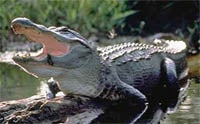The Red Book List
Take a look at the common and scientific names on the 1964 list (below). Can you tell which is the common name and which is the scientific? One of the first things you should notice about the scientific names is that some of the species have two names while other have three. The ones with three names are not just species, but a small group within species called a "subspecies."
Try This Activity

The complete 1964 list of endangered species is below. The list contains the common and scientific names that scientists used back when the list was first made. In some cases the names have changed since they were first listed. In other instances the name is the same. For example the common and scientific name of the American Alligator has not changed. In the case of the Puerto Rican Parrot it was considered to be a subspecies in 1964 (it had three names) and is now considered a full species (with only two names). Several species on the list below are linked to the Encyclopedia of Life (EOL) followed by an explanation of how its name has changed from then to now. Once you see how names can change, try using EOL to look up other species to see if they also have changed.
1964 Red Book List
Mammals

Kaibab Squirrel (Sciurus kaibabensis) – was a species in 1964, changed to a subspecies on EOL. How do you know: went from two names to three names.
Eastern Fox Squirrel (Sciurus niger)
Utah Prairie Dog (Cynomys parvidens) - Same
Beach Meadow Vole (Microtus breweri)
Block Island Meadow Vole (Microtus pennsylvanicus provectus)
Glacier Bear (Ursus americanus emmonsii)
Grizzly Bear (Ursus horribilis) – Species name changed. How do you know: the second name changed. Look at the classification bar on the right of the EOL page. Can you find the horribilis subspecies of grizzly bear? What is its common name?
Polar Bear (Thalarctos maritimus)
Black-footed Ferret (Mustela nigripes)
Southern Sea Otter (Enhydra lutris nereis)
Pacific Walrus (Odobenus rosmarus divergens)
Florida Manatee (Trichechus manatus latirostris)
Tule Elk (Cervus nannodes)
Key Deer (Odocoileus virginianus clavium)
Bighorn Sheep (Ovis canadensis)
Birds

Nene (Branta sandvicensis) – under a different common name. Scroll down the left side of the EOL page and find the “names and taxonomy” tab. Click on the synonyms (old scientific names) and common names and see if you can find “nene.”
Aleutian Canadian Goose (Branta canadensis leucopareia)
Tule White-fronted Goose (Anser albifrons gambelli)
Northern Mexican Duck (Anas diazi novimexicana)
Laysan Duck (Anas wyvilliana laysanensis)
Hawaiian Duck (Anas wyvilliana wyvilliana)
California Condor (Gymnogyps californianus)
Florida Everglade Kite (Rostrhamus sociabilils plumbeus)
Southern Bald Eagle (Haliaeetus leucocephalus leucocephalus)
Greater Prairie Chicken (Tympanuchus cupido pinnatus)
Attwater’s Prairie Chicken (Tympanuchus cupido attwateri)
Masked Bobwhite (Colinus virginianus ridgwayi)
Whooping Crane (Grus americana)
Florida Sandhill Crane (Grus canadensis pratensis)
Hawaiian Gallinule (Gallinula chloropus sandvicensis)
Hawaiian Stilt (Himantopus himantopus knudseni)
Eskimo Curlew (Numenius borealis)
Puerto Rican Parrot (Amazona vittata vittata) – was a sub species in 1964 and is now considered a full species. How do you know: see above.
Ivory Billed Woodpecker (Campephilus principalis)
Hawaiian Crow (Corvus tropicus)
Puaiohi (Phaeornis palmeri)
Nihoa Miller-bird (Acrocephalus kingi)
Kauai Oo (Moho braccatus)
Kauai Akialoa (Hemignathus procerus)
Kauai Nukupuu (Hemignathus lucidus Hanapepe)
Maui Parrotbill (Pseudonestor xanthophrys)
Ou (Psittirosta psittacea)
Palila (Psittirostra bailleui)
Nihoa Finch (Psittirostra cantans ultima)
Crested Honey-creeper (Palmeria dolei)
Bachman’s Warbler (Vermivora bachmanii)
Kirtland’s Warbler (Dendroica kirtlandi)
Golden-cheeked warbler (Dendroica chrysoparia)
Dusky Sea Sparrow (Ammospiza nigrescens)
Cape Sable Sparrow (Ammospiza mirabilis)
Ipswich Sparrow (Passerculus princeps)

Reptiles
Green Turtle (Chelonia mydas mydas)
American Alligator (Alligator mississippiensis) – Same
American Crocodile (Crocodylus acutus)

Amphibian
Texas Blind Salamander (Typhlomolge rathbundi) – Reclassified into a new genus. How do you know: the first of the two names have changed.
Deep Springs Toad (Bufo exsul)
Fishes
Atlantic Salmon (Salmo salar)
Arctic Grayling (Thymallus arcticus)
Lahontan Cutthroat Trout (Salmo clarki henshawi)
Olympic Mudminnow (Novumbra hubbsi)
Ohio Muskellunge (Esox masquinongy ohioensis)
Maryland Darter (Etheostoma sellare)
Read more about: Making the List
Bibliographic details:
- Article: The Red Book List
- Author(s): Dr. Biology
- Publisher: Arizona State University School of Life Sciences Ask A Biologist
- Site name: ASU - Ask A Biologist
- Date published:
- Date accessed:
- Link: https://askabiologist.asu.edu/red-book-list
APA Style
Dr. Biology. (). The Red Book List. ASU - Ask A Biologist. Retrieved from https://askabiologist.asu.edu/red-book-list
Chicago Manual of Style
Dr. Biology. "The Red Book List". ASU - Ask A Biologist. . https://askabiologist.asu.edu/red-book-list
Dr. Biology. "The Red Book List". ASU - Ask A Biologist. . ASU - Ask A Biologist, Web. https://askabiologist.asu.edu/red-book-list
MLA 2017 Style

A recent debate over the spotting of the Ivory Billed Woodpecker shows that it is not always easy to know when the last of a species is gone.
Be Part of
Ask A Biologist
By volunteering, or simply sending us feedback on the site. Scientists, teachers, writers, illustrators, and translators are all important to the program. If you are interested in helping with the website we have a Volunteers page to get the process started.


